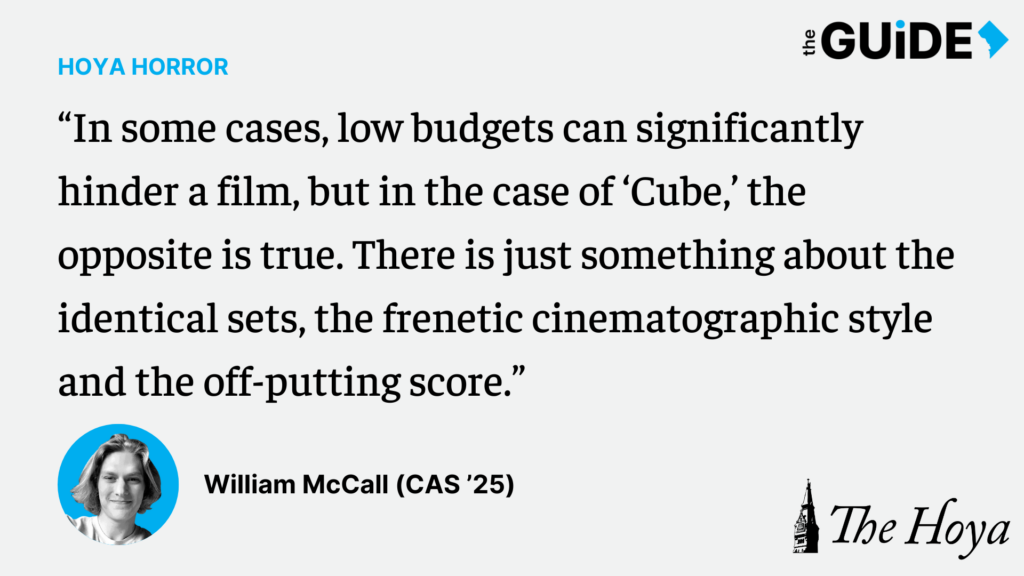“Cube” (1997), directed by Vincenzo Natali, the mind behind “In the Tall Grass” (2019) and “Splice” (2009), occupies a strange position in horror cinema — one worth revisiting in honor of the film’s recent Japanese remake, which released to U.S. audiences April 11 as a SCREAMBOX Original.
Simultaneously innovative, dated, engaging and grating, “Cube” is one of the earliest instances of escape horror, a subgenre eventually popularized by “Saw” (2004). Escape horror is fairly straightforward, frequently built around an eclectic collection of strangers, mysteriously trapped in some sort of structure that they must escape, lest they suffer the often fatal consequences.
In the case of “Cube,” the structure is a massive, well, cube, composed of thousands of box-like rooms rigged with deadly traps. Its would-be victims? Egghead student Leaven, played by Nicole de Boer; police officer Quentin, played by Maurice Dean Wint; serial nihilist Worth, played by David Hewlett; doctor Holloway, played by Nicky Guadagni; escape artist Rennes, played by Wayne Robson; and savant Kazan, played by Andrew Miller.
It’s an intriguing premise, and “Cube” makes the most of it, letting the bizarreness of the setting work its magic. Horror has often relied heavily on iconic settings that do some of the terror-inducing heavy liftings; “Cube” is no different. Indeed, perhaps the best part of Natali’s film debut is the cube itself, a byzantine labyrinth of solid-state patterning and ominous, mechanical ambiance that plunges the viewer into a claustrophobic state of disorientation.
“Cube’s” limited budget, $350,000 — a pittance even compared to relatively “cheap” horror productions like “A Nightmare on Elm Street,” which had a budget of $1.1 million or “The Babadook,” which had $2 million budget — makes it even more impressive.
In some cases, low budgets can significantly hinder a film, but in the case of “Cube,” the opposite is true. There is just something about the identical sets, the frenetic cinematographic style and the off-putting score. All of it worms its way underneath the viewer’s skin as the Cube’s prisoners feverishly work to escape their quadrilateral enclosure.
It’s unclear how much of the film’s messiness is deliberate and how much is incidental, but regardless, it works. So much so that at a certain point, I found myself entirely uninterested in the mystery of the Cube itself — a mystery that, by all accounts, should be the main concern in a movie like this one.
All that matters is the visceral emotional response the Cube elicits in its audience. In fact, having grown up in an era of cinema where so many things are painfully explicit or over-explained (looking at you, “Star Wars: The Rise of Skywalker”), it is refreshing to watch a film that places atmosphere over the nitty-gritty.
“Cube” presents a particular brand of terror. In sharp contrast to the heavy-handed “torture porn” of “Saw” or the decidedly class-based discourse of “Escape Room” (2019), Natali focuses on the everyday horror of both physical and existential confinement — finding oneself trapped within a vast apparatus that does nothing but make one’s life a living hell for no reason.
It’s tragically cosmic, transcending the typical Hollywood binaries of good vs. evil, hero vs. villain, etc. Yet — like so much else in “Cube” — Natali’s themes are simultaneously accessible and universally applicable, allowing viewers to map their own anxieties about corporate monoculture, government overreach or postmodern angst at large onto his film.
However, for all of its strengths, “Cube” has a couple of weaknesses. Most egregious among them: the cast. As with many tight-pursed productions, “Cube’s” acting remains a major issue, with countless lines delivered utterly devoid of nuance or craft. De Boer is especially erratic, at times delicately precocious and at others completely insufferable.
“Cube’s” bargain-basement aesthetic also backfires a bit — especially whenever the film uses CGI. However, the few practical effects in Natali’s film are strong enough for me to overlook this specific deficiency.
Overall, “Cube” certainly remains a worthwhile film to reexamine, even if it is only as a warmup for some of April’s exciting horror offerings. So, in between screenings of “Renfield” (2023) and “Beau is Afraid” (2023), don’t be shy about queuing up Natali’s time-honored classic. After all, in the words of Huey Lewis, “It’s hip to be square.”
William McCall is a sophomore in the College of Arts & Sciences. Hoya Horror will appear online and in print every three weeks.















